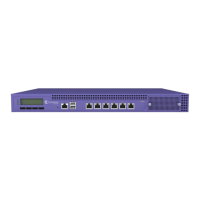Table 56: Custom Application Settings
Field Description
Group Internet applications are organized in groups based on the type or
purpose of the application. Once you select an Application Group, the
Application Name drop-down is populated with application names
that are part of the specified group.
The group names are pre-defined standard Extreme Application
Analytics
™
signature groups. The group names are case-sensitive.
Name The name of the custom application.
Pattern The Matching Pattern is the URL pattern that is associated with the
application (case-sensitive, up to 64 characters).
Class of Service
In general, COS refers to a set of attributes that define the importance of a frame while it is forwarded
through the network relative to other packets, and to the maximum throughput per time unit that a
client or port assigned to the role is permitted. The CoS defines actions to be taken when rate limits are
exceeded.
A role can contain default access control (VLAN) and/or Class of Service (priority) characteristics that
will be applied to trac when the rule either allows trac, or does not specifically disallow trac and
the last rule is ALLOW ALL.
Class of Service is a 3-bit field that is present in an Ethernet frame header when 802.1Q VLAN tagging is
present. The field specifies a priority value between 0 and 7, more commonly known as CS0 through
CS7. These values can be used by QoS disciplines to dierentiate and shape or police network trac.
CoS operates only on 802.1Q VLAN Ethernet at the data link layer (Layer 2), which other QoS
mechanisms (such as DiServ, also known as DSCP) operate at the IP network layer (Layer 3).
After packets are classified, they are assigned a final User Priority (UP) value, which consists of the
Priority and ToS/DSCP. Marking bits to be applied to the packet is taken from the CoS, and if the value is
not set, then the received value (ToS/DSCP) is used. ToS/DSCP Marking rewrites the Layer 3 Type of
Service (ToS) byte.
Related Links
Configuring CoS on page 135
Configuring ToS/DSCP on page 136
Configuring CoS
The set of rules included in a role, along with any access or CoS defaults, determine how all network
trac of any client assigned to the role will be handled. For example, a Doctor role can be assigned a
higher priority CoS and default access control due to the sensitivity and urgency of services that a
doctor provides to patients.
1 Go to Configure > Policy > Class of Service.
2 Select Add, or select an existing Class of Service from the list.
Configure
ExtremeCloud Appliance User Guide for version 4.36.03 135

